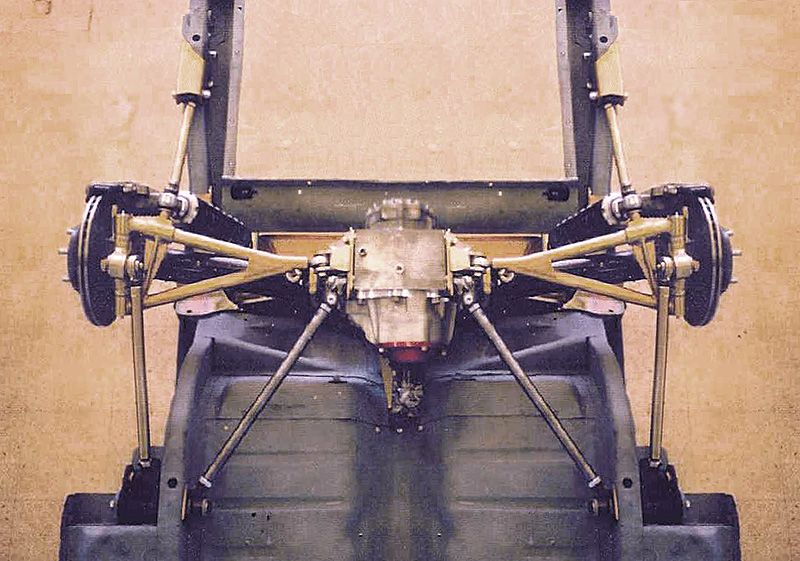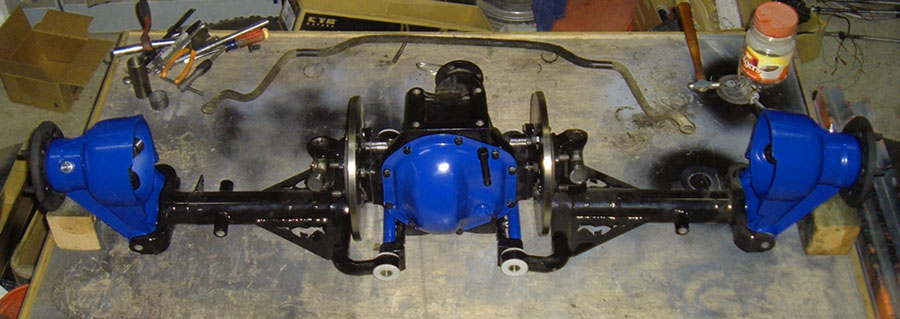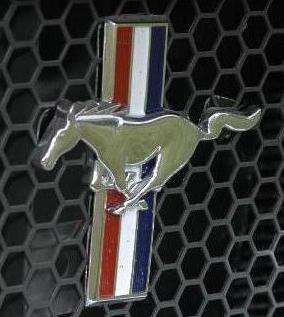

 |
 |
 |
 |
 |
You are not logged in. Would you like to login?

![]() Offline
Offline
Here's my C3 front end - with the SPC Upper (adjustable) Control Arms and the Howe extended Ball Joints.
RC is just over 1.25 inches Above Ground Level, and the migration is "slight"at 3 degrees of roll.
Gives up a bit of camber, at about 2:3 (2 degrees for 3 degrees roll).
This is where I start. Then, I design the rear so the RC is 2 to 4 inches AGL, has less migration, and retains more camber gain.
These dimensions are "close"as they were taken while the whole chassis is under rebuild. I satisfied they'll be close enuf.
Cheers - Jim
![]() Offline
Offline

Interesting stuff. The Arntz Butler used the same MG front suspension, control arms are definitely not parallel. It'll be next week before I put the car back on the lift but I'll have a closer look then and try to take some measurements. But just from the sound of it, it would seem that the RC at both ends is going to be fairly low, with possibly the rear a little higher. Now if only I could find the info on CG.
Jim
![]() Offline
Offline

Apparently I was wrong. I'll try to check physical parts in the next day or two but the MG guys tell me that the control arms ARE parallel. That would put the instant center midway between the arms at infinity, making the RC just slightly above the ground. I'm still trying to get info on the CG.
Anyone know what the roll center for the Jag IRS is? Any estimate of the rear CG on, say a Cobra for instance?
Jim
![]() Offline
Offline

Jim,
That's a question that can't be answered with a definitive answer. In viewing multiple pictures with the halfshafts pointing downward/level and upward. They all would have a different RC's. Add to that narrowing by some guys, the RC can be statically at many heights. Wheel offsets, tire diameters and tire widths also play into the equation.
I think I can make a fairly good guess, but exact? Without actually measuring what you have is, I think impossible.
Take a AC Cobra, many kits have OEM style suspension parts. I know the CG is fairly low compared to the OEM donor. Add this lower CG to a OEM RC and your going to have a higher weight percentage transfer to the outside. This whole exercise is making sense to me in other respects. As I posted once, reading at CC guys are telling others to remove the rear anti sway bar. I also read the MII's front anti sway bar is plenty stout. Again the lower CG of a Cobra is the reason. Imagine taking a car or truck like say a S10 and bringing the CG way lower. Seems to me everything would tighten up. This is my rough guess anyhow. Maybe others can correct me if I'm wrong.
I know this sounds backwards but as stated a high RC causes a loose condition over either axle putting more weight on the outside tires. The front creating under steer/ rear over steer. Ratio wise it would seem to me I effectively would have tightened everything up by narrowing the distance between the CG and RC.
HELP, LOL!
I think you would want to lower the RC. Maybe it's the lower leverage due to the lower CG.
Ralphy
Last edited by Ralphy (5/03/2012 9:33 am)
![]() Offline
Offline

Jim,
You need to make a diagram of the front and rear if you want to see where the roll centers are. A few minutes with a tape measure and you can make a diagram on some graph paper.
![]() Offline
Offline

Just wanted to get general feel for it. Knowing the details will not affect how the car handles. Anyway it looks very much like the front RC is at or near ground level and the front CG cannot be improved any further. Apparently the rear RC is a bit higher and the rear CG may be higher as well but it may be lower. So the rear moment arm is likely shorter, which goes well with the softer, longer travel rear suspension. All in all I think the result is pretty well balanced out.
Jim
![]() Offline
Offline
Jim -
That description sounds like a well balanced set up. You can always tweak it a bit with wider tires, spacers, or bars.
Worthwhile to start as "clean" as you can then adjust!
Congratulations.
Cheers - Jim
![]() Offline
Offline

Thanks Jim. The one that is on the road seems to handle pretty nicely, and so far everyone who has driven it has been well impressed with it (somewhere between one and two dozen drivers). It has no roll bars but feels pretty well balanced. At the limit we get a slight rub somewhere in the back but it is so little we haven't been able to determine where it is yet. Might just be a matter of a couple hammer strokes, or we could fit roll bars.
My car has bigger diameter tires and rides a little higher. It also uses stagger with a 315/35-17 rear and 265/45-17 front (I think) and has a posi with fairly stiff preload, all of which affects the handling. But I think it'll be within reason.
If I could get some sort of a handle on the Jag RC it'd tell me a lot about the roll axis of the car. We took a stock XJ6 unit and narrowed it 5-1/4" IIRC, 3" off one side and 2-1/4" off the other to center the driveshaft. Naturally that will shift the RC slightly and I might build the next one centered just because of all the questions that causes, but unless you put the driver in the center of the car I can't see it really making any difference. In fact it could very well offset driver weight.
So it seems to me that the Jag IRS is generally set up within a range between level half shafts and level LCAs. My thinking is that level half shafts is probably correct. The MGB rear suspension of course has the RC at the level of the spring hangers. Well, more accurately I guess, where the line from the front spring hanger to the shackle hanger intersects the vertical plane of the axle. At least that is my understanding of how it is located. What I would like to determine is if that point is within the range mentioned above, or how much above it. If the half shafts are level then the IC is going to be at the level of the half shafts or wheel center, some distance out so clearly the RC should be perhaps just something like 2-4" above the ground.
If true, this greatly reduces the angle of the roll axis. Anyone care to elaborate on the results of that change? Assuming of course that my analysis in on the money. If not, please do correct it.
Jim
Last edited by Jim Blackwood (5/05/2012 10:36 am)
![]() Offline
Offline

Just for kicks, I did a real quick roll center diagram on my Jag install in the '65 Mustang with the half shafts level. It came out 5 inches above ground. I figure this is where the RC will be when I load the trunk with food and beer and head for a picnic with the wife and grandkids.
Last edited by irstang (5/05/2012 9:42 pm)
![]() Offline
Offline

Fantastic! Thank you Jim, that was exactly where I was headed with this. If I take a rough estimate of the stock MGs rear RC being in the center of the axle, (which is probably not far off) that would be about 12" above the ground. So the Jag IRS reduces the roll axis inclination to a bit less than half what it was before.
Jim
![]() Offline
Offline

Hi Jim,
Big Buick torque coupled with the ride of a Jaguar. Awesome.
This exercise in roll center/moment center has increased my confidence a bunch. I wish I was as far as long as you so I could go for a ride. When my car is empty it is one inch higher and the roll center moves up 1 and 1/2 inches.
For reference, another tidbit, I read that the rear roll center on a '63 'vette is 8.13 inches above ground.
Cheers,
Douglas
![]() Offline
Offline

While searching the web I found a link to a good suspension design power point presentation.
Forgive me for perusing another forum, but here is an interesting look at roll centers and suspension geometry.
The Eng-tips forum has a wealth of information on suspension design,
![]() Offline
Offline

Doug, a higher RC puts more load on the outer tire in corners? Yes?
Quote, "In summary, think of roll-centres like anti-dive, reject any attempts to turn it into voodoo and find a good vehicle dynamics book. And set your static camber to maximise tyre life with the camber change characteristics you have, use tyre temperatures to predict tyre life without actually wearing them out."
Ralphy
Last edited by Ralphy (4/14/2013 6:46 am)
![]() Offline
Offline

No. Take a look at slide 37 of the presentation. The roll moment, with the center of gravity above the roll center, creates the forces used to plant the tires in a corner. As the body rolls, a properly designed suspension loads the tires vertically on the outside of a turn.
As I recall, the front roll center of your Cobra is well located at ground level and you are trying to determine where the static roll center at the rear should be. You might want to steal some advice from one of Mark Ortiz's columns: Also, I think Phantomjock posted a "tune up" guide from my hero, Caroll Smith. As I recall it gives one insight into the effect of rear roll center location on handling when you are ready to road test your design.
Last edited by irstang (4/14/2013 12:01 pm)